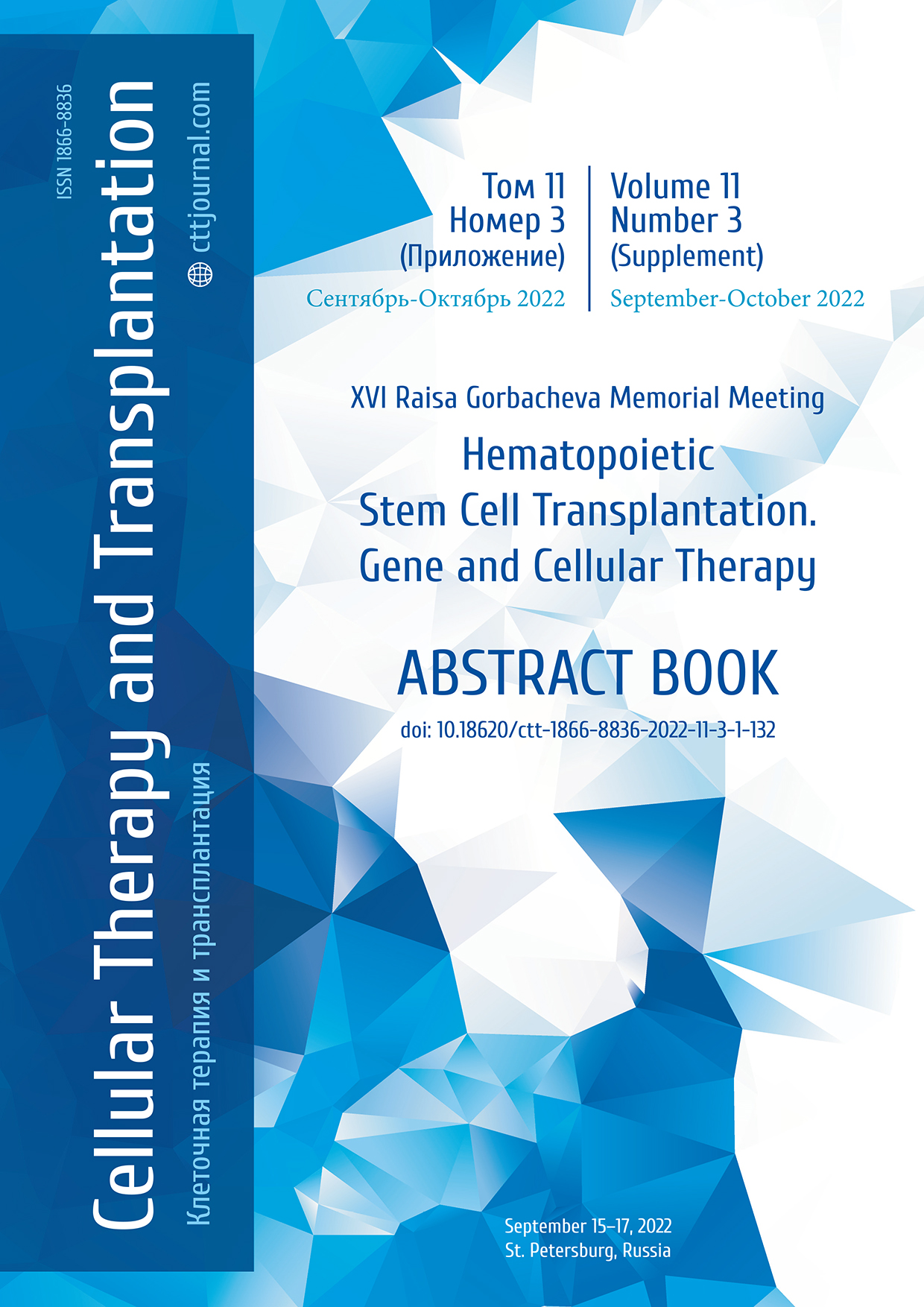AL-05. First results of the “Cooperative Program for Diagnosis and Treatment of Acute Myeloid Leukemia in Russian Federation” implementation
Sergey N. Bondarenko1, Dmitrii K. Zhogolev1, Bella I. Ayubova1, Anna G. Smirnova1, Tatiana L. Gindina1, Elena V. Babenko1, Ildar M. Barkhatov1, Natalia E. Ivanova1, Tatiana S. Shchegoleva1, Veronika V. Ermolina1, Nikita P. Volkov1, Varvara I. Bakhtina2, Natalya N. Glonina3, Ksenia S. Dedyukhina4, Yuri A. Dunaev5, Tatiana S. Kaporskaya6, Elena G. Kirillova7, Vladimir A. Kobiyasov8, Tatiana S. Konstantinova9, Marina V. Kosinova10, Tatiana I. Ksenzova11, Alexander A. Myasnikov12, Irina A. Novokreshenova13, Olesya S. Kuznetsova14, Tatiana I. Olkhovik15, Elena A. Pashneva16, Anastasia G. Petukhova17, Andrey V. Proydakov18, Kirill V. Rytov19, Victoria V. Ryabchikova20, Irina A. Samorodova20, Olga S. Samoilova21, Irina V. Trukhan22, Ekaterina A. Ukrainchenko23, Olga S. Uspenskaya24, Maria V. Frolova25, Yuri V. Shatokhin26, Rada H. Ebzeeva27, Angelina V. Talko28, Konstantin P. Novoselov29, Alina G. Karpova30, Ivan S. Moiseev1, Alexander D. Kulagin1
1 RM Gorbacheva Research Institute, Pavlov University, St. Petersburg, Russia
2 Regional Clinical Hospital №1, Krasnoyarsk, Russia
3 Regional Clinical Hospital №1, Khabarovsk, Russia
4 Zabaikalsky regional oncological dispensary, Chita, Russia
5 Arkhangelsk
Regional Clinical Hospital, Arkhangelsk, Russia
6 Irkutsk Regional Clinical Hospital, Irkutsk, Russia
7 Regional Clinical Hospital, Omsk, Russia
8 Pskov Regional Clinical Hospital, Pskov, Russia
9 Sverdlovsk Regional Clinical Hospital №1, Yekaterinburg, Russia
10 Kuzbass S. V. Belyaev Regional Clinical Hospital, Kemerovo, Russia
11 Regional Clinical Hospital №1, Tyumen, Russia
12 Republican V. A. Baranov Hospital, Petrozavodsk, Russia
13 Clinical Hospital “RZhD-Medicine”, Smolensk, Russia
14 Novokuznetsk A. A. Lutsik City Clinical Hospital №29, Novokuznetsk, Russia
15 Krasnoyarsk Interdistrict Clinical Hospital №7, Krasnoyarsk, Russia
16 Volgograd Regional Clinical Oncological Dispensary, Volgograd, Russia
17 Korolev City Hospital, Korolev, Russia
18 Komi Republican Oncological Dispensary, Syktyvkar, Russia
19 Regional Clinical Hospital, Barnaul, Russia
20 City Clinical Hospital №31, St. Petersburg, Russia
21 Nizhny Novgorod N. A. Semashko Regional Clinical Hospital, Nizhny Novgorod, Russia
22 Murmansk Regional P. A. Bayandin
Clinical Hospital, Murmansk, Russia
23 Alexander Hospital, St. Petersburg, Russia
24 Leningrad Regional Clinical Hospital,
St. Petersburg, Russia
25 Vologda Regional Clinical Hospital, Vologda, Russia
26 Rostov State Medical University, Rostov-on-Don,
Russia
27 Karachay-Cherkess S. P. Butov Oncological Dispensary, Cherkessk, Russia
28 Regional Clinical Hospital №2, Vladivostok, Russia
29 Novgorod Regional Clinical Hospital, Velikiy Novgorod, Russia
30 Republican N. A. Semashko Clinical Hospital, Ulan-Ude, Russia
Contacts: Dr. Sergey N. Bondarenko, phone: +7 (921) 994-35-70, e-mail: dr.sergeybondarenko@gmail.com, Dr. Dmitrii K. Zhogolev, phone: +7 (911) 787-92-08, e-mail: dr.zhogolev@gmail.com
Summary
Currently, the population data concerning treatment efficacy in adult patients with acute myeloid leukemia (AML) are virtually absent in Russian Federation. Moreover, according to some limited observation series, the survival rate for this disorder does not exceed 10-20%. To determine population characteristics and treatment results of AML patients in Russia, a Cooperative Program for the Diagnosis and Treatment of Acute Myeloid Leukemia in Russian Federation was initiated by the Tin’kov Family Foundation. The key parameters of the program include early immunophenotypic and molecular, as well as cytogenetic diagnostics and HLA typing, providing early access to allogeneic hematopoietic stem cell transplantation (allo-HSCT) for the risk groups with intermediate and unfavorable genetic findings.
Patients and methods
This analysis was performed in an initial cohort of 200 patients enrolled from 29 participating centers since October 2021 to August 2022. After signing an informed consent form and evaluating compliance with inclusion criteria, the patients were subject to routine diagnostics, as well as to karyotyping, immunophenotyping, molecular genetic analyses of the bone marrow. HLA typing of the patients and potential donors was performed at the facilities of RM Gorbacheva Research Institute.
Results
The primary diagnosis of AML was confirmed in 82.5% of patients (n=165). Acute lymphoblastic leukemia was diagnosed in 6.5% (n=13); acute promyelocytic leukemia, in 4.5% (n=9); myelodysplastic syndrome, in 3.5% (n=7), and other diagnoses were established in 3% of cases (n=6). Further analysis was performed in the verified AML group. The median follow-up time for the living patients was 54.5 (18-307) days. The female-to-male ratio was 53.9% versus 46.1% (89 to 76 cases, respectively), with median age of 52 years old (18 to 83). When stratified by the ELN criteria, favorable risk was defined in 20% of patients (n=33), intermediate, in 50.3% (n=83); unfavorable, in 29.7% (n=49). AML with myelo-dysplasia-related changes was diagnosed in 18.8% (n=31) of patients, and 6.7% (n=11) have undergone prior chemotherapy due to another malignancies. According to the results of cytogenetic examination (n=114), aberrant karyotypes were found in 56% (n=64), complex karyotype was detected in 11.4% of cases (n=13). According to results of molecular genetic analysis, mutations were most often detected in FLT3 (35/141, 24.8%) and NPM1 (30/139, 21.6%) genes. In the group of patients who underwent induction therapy (n=110), complete remission was achieved in 47% (n=52) of cases, whereas 16% of the patients (n=17) were primarily refractory, early mortality was registered in 37% (n=41). In the group of patients who underwent allo-HSCT (n=12), the median time from the time of diagnosis to HSCT was 189 days (104 to 266). Allo-HSCT from matched related, matched unrelated, mismatched unrelated and haploidentical donors was carried out in 33.3% (n=4), 8.3% (n=1), 41.7% (n=5) and 16.7% (n=2) of patients, respectively. Allo-HSCT was performed in the first complete remission in 66.6% (n=8) of cases; in the state of active disease, in 33.4% (n=4). Early mortality was 12.5% among the patients who achieved remission (n=1), being 75% (n=3) in the active disease group. The median follow-up time after allo-HSCT for survivors was 60 days.
Conclusion
As seen from the first results of the Cooperative Program for the Diagnosis and Treatment of Acute Myeloid Leukemia in the Russian Federation, a large proportion of genetically unfavorable AML forms was revealed. We have also noted high percentage of early mortality and long median time before allo-HSCT were. During further development of the program, one should overcome these major barriers in order to improve the survival rates.
Keywords
Acute myeloid leukemia, allogeneic hematopoietic stem cell transplantation, cooperative program.


